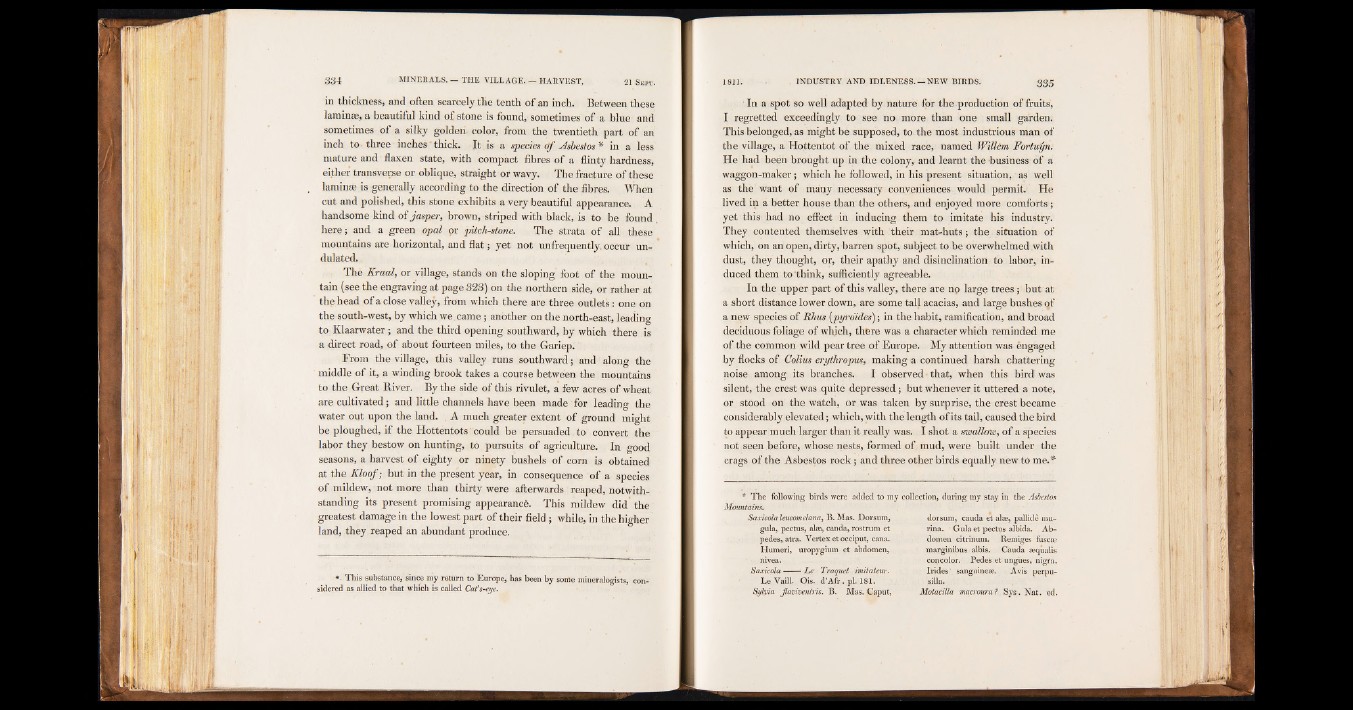
in thickness, and often scarcely the tenth of an inch. Between these
laminae, a beautiful kind of stone is found, sometimes of a blue and
sometimes of a silky golden, color, from the twentieth part of an
inch to-three inches ' thick. It.is a species <tf Asbestos* in a less
mature and flaxen state, with compact fibres of a flinty hardness,
either transverse or oblique, straight or wavy. The fracture of these
laminae is-generally according to the direction of the fibres. When
cut and polished, this stone exhibits a very beautiful appearance. A
handsome kind of Jasper, brown, striped with black, is to be found
here; and a green opal or pitch-stone. The strata of all these
mountains are horizontal, and flat; yet not unfrequently, occur undulated.
.
The Kraal, or village, stands on the sloping foot of the mountain
(see the engraving at page 323) on the northern side, or rather at
the head of a close valley, from which there are three outlets: one on
the south-west, by which we came; another on the north-east, leading
to Klaarwater ; and the third opening southward, by which there is
a direct road, of about fourteen miles, to the Gariep.
From the village, this valley runs southward; and along the
middle of it, a winding brook takes a course between the mountains
to the Great River. By the side of this rivulet, a few acres of wheat
are cultivated; and little channels have been made for leading the
water out upon the land. A much greater extent of ground might
be ploughed, if the Hottentots' could be persuaded , to convert the
labor they bestow on hunting, to pursuits of agriculture. In good
seasons, a harvest of eighty or ninety bushels of corn is obtained
at the Kloof ; but in the present year, in consequence of a species
of mildew, not more than thirty were afterwards reaped, notwithstanding
its present promising appearance. This mildew did the
greatest damage in the lowest part of their field ; while, in the higher
land, they reaped an abundant produce.
». This substance, since niy return to Europe, has been by some mineralogists, con-
sidered as allied to that which is called Cats-eye.
In a spot so well adapted by nature for the production of fruits,
I regretted exceedingly to see no more than one small garden.
This belonged, as might be supposed, to the most industrious man of
the village, a Hottentot of the mixed race, named WilUm Fortuyn.
He had been brought up in the colony, and learnt the business of a
waggon-maker; which he followed, in his present situation, as well
as the want of many necessary conveniences would permit. He
lived in a better house than the others, and enjoyed more comforts;
yet this had no effect in inducing them to imitate his industry.
They contented themselves with their mat-huts; the situation of
which, on an open, dirty, barren spot, subject to be overwhelmed with
dust, they thought, or, their apathy and disinclination to labor, induced
them to ‘think, sufficiently agreeable.
In the upper part of this valley, there are no large trees; but at
a short distance lower down, are some tall acacias, and large bushes qf
a new species of Rhus (pyroides); in the habit, ramification, and broad
deciduous foliage of which, there was a character which reminded me
of the common wild pear tree of Europe. My attention was engaged
by flocks of Colius erythropus, making a continued harsh chattering
noise among its branches. I observed that, when this bird was
silent, the crest was quite depressed; but whenever it uttered a note,
or stood on the watch, or was taken by surprise, the crest became
considerably elevated; which, with the length of its tail, caused the bird
to appear much larger than it really was. I shot a swallow, of a species
not seen before, whose nests, formed of mud, were built under the
crags of the Asbestos rock; and three other birds equally new to me.*
* The following birds were added to my collection, during my stay in the Asbestos
Mountáins.
Saxícolaleucomelana, B. Mas. Dorsum, dorsum, cauda et alae, pallide maguía,
pectus, alae, canda, rostrum et rina. ■ Gula et pectus albida. Abpedes,
atra. Vertex et occiput, cana. domen citrinum. Remiges fuscae
Humeri, uropygium et abdomen, marginibus albis. Cauda aeqitalis
• nivea. concolor. Pedes et ungues, nigra.
Saxícola L e Traquet imitateur. Irides sanguíneas. Avis perpu-
Le Vaill. Ois. d’Afi*. pi. 181. silla.
Sylvia Jlavivenir is. B. Mas. Caput, Motacilla macrouraf. Sys. Nat. ed.